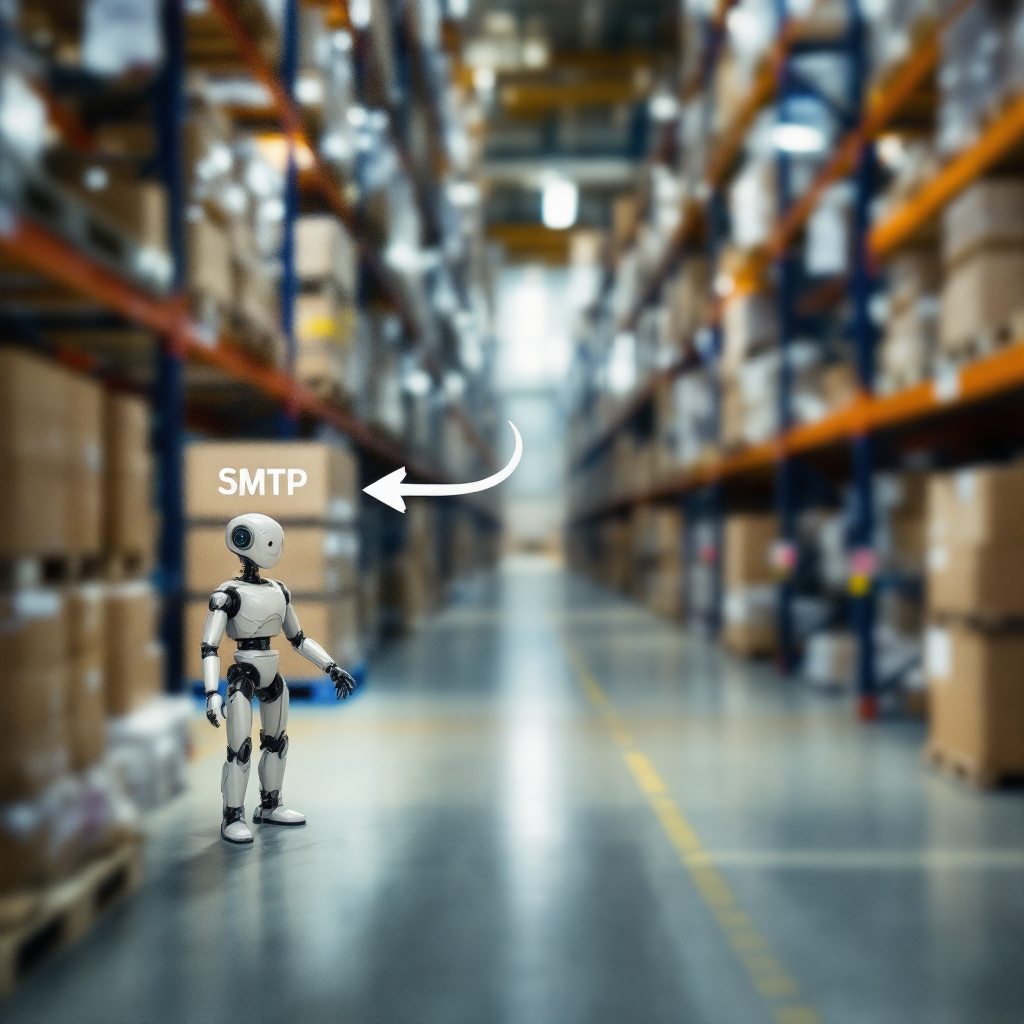ai + mta: how an ai email agent connects to a mail transfer agent
An AI email agent composes and scores text, and then hands the message to a mail transfer agent for delivery. First, the AI drafts content, applies rules, and personalizes the subject lines and body. Next, the agent submits the outgoing mail using SMTP to the MTA. The MTA then queues and routes each internet message toward the recipient server. This flow mirrors how classic mail user agent patterns work, yet the AI adds context, speed, and decisioning. A mail transfer agent, sometimes called a message transfer agent, handles the heavy lifting: queuing, retrying, routing, and handing mail to the next hop. Common MTA implementations include Postfix, Exim, and Exchange. For mail clients like a mail client or MUA, the MTA appears as the sending layer that moves mail off a user’s device into the wider mail transport. In an integrated stack, a mail submission agent accepts mail from a mail user, then passes it to the MTA or MSA. Meanwhile, a mail delivery agent performs final delivery into the mailbox or hands mail to an MDA. The mail transport agent sits at the heart of this mail flow. AI can read delivery receipts, SMTP responses, and bounce metadata to adapt content and cadence. That closed-loop optimisation helps reduce retries and avoids the spam folder. For teams that process many support threads, this connection speeds replies and preserves context across threads and systems. virtualworkforce.ai uses data fusion to ground drafts in ERP and email memory, so replies cite facts and remain auditable. For an authoritative definition of email and internet message structure, see Email on Wikipedia.

smtp relay, smtp and queue: relaying through an email provider
A cloud SMTP relay provides scale, reputation management, and dashboards that track delivery routes. Providers offer cloud-based smtp relays with dedicated IPs, analytics, and SDKs to manage large volumes. The SMTP relay abstracts rate limits, and it improves IP reputation for the sender. When the MTA hands mail to a mail relay, the provider records delivery attempts and returns status codes. Those analytics feed into the AI so it can adjust subject lines and send patterns intelligently. The MTA queue holds messages awaiting retries, and the queue mechanics determine retry policy, timeouts, and prioritisation. Set sensible retry windows and priority tiers to prevent buildup. For example, you should monitor queue size, and you must surface slowdowns before they impact inbox placement. Use TLS and SMTP authentication to secure outgoing mail and to satisfy modern authentication needs. Also ensure DNS records align with SPF, DKIM, and DMARC to protect domain reputation. Poor DNS setup or missing DKIM can push messages into the spam folder or to disposable inboxes. Cloud relays also help manage bounce handling and parse feedback from ISPs, which is key for long term mail flow health. Backlinko highlights that mobile opens dominate many campaigns and that proper relay configuration ensures consistent rendering across devices, so test for IMAP and POP3 clients too (Backlinko email statistics).
Drowning in emails? Here’s your way out
Save hours every day as AI Agents draft emails directly in Outlook or Gmail, giving your team more time to focus on high-value work.
automation and ai email: email drafting for personalized emails
AI simplifies high volume email drafting and delivers consistent, personalized emails at scale. Use cases cover transactional replies, sales quote generation, and dynamic marketing content. For example, Quote Specialist AI Agents automate quote creation from inbound email requests and reduce manual steps (Quote Specialist AI Agents). An ai agent can assemble order data, pick correct templates, and draft a reply that cites ERP values. Then the draft remains editable so an operator can verify facts. That auditability keeps email agent transforms transparent and compliant. Personalised emails that match customer context raise engagement. Apply A/B testing to subject lines and content blocks. Monitor open rates to refine timing and copy; industry averages show healthy engagement, with an average open rate above 42% in recent benchmarks (HubSpot open rate benchmarks). Keep templates aligned with brand voice, and build escalation paths for exceptions. For logistics teams, virtualworkforce.ai connects to ERP/TMS/WMS and SharePoint to ground every reply in operational data. This design reduces handling time and prevents data hunting during onboarding. Use langchain or LLMS-based orchestration only where you can log decisions. In practice, an AI that writes fast must also create auditable trails so teams can comply with policies and protect customer journeys across systems. For more on AI-assisted drafting in logistics, see our logistics email drafting solution (logistics email drafting AI).
email deliverability, inbox and mtas: how MTAs affect placement
MTAs directly influence whether messages reach the inbox or fall into the spam folder. Proper MTA configuration ensures valid rDNS, warmed IPs, and aligned authentication. Authentication, including SPF, DKIM, and DMARC, signals trust to ISPs. If you miss a DKIM signature or if SPF fails, many ISPs will lower delivery priority. A healthy mail server and good mail transport practices reduce bounce rate and complaints. Track open rates and other engagement metrics to see the impact email has on recipient behaviour. Remember that average open rates still hover at a strong level, so optimising MTA behaviour can convert small gains into meaningful lift. ISPs provide feedback loops and complaint feeds you should subscribe to. Also separate transactional and marketing streams and consider dedicated IPs where necessary to protect deliverability for critical messages. A mail delivery agent hands messages into user mailboxes, and the interaction between that agent and the MTA controls final placement. Monitor sender reputation, and use the MTA to throttle traffic on poor-performing delivery routes. For teams overwhelmed by email volume, a focused solution reduces errors and speeds replies; see our approach for virtual assistants in logistics (virtual assistant for logistics).

Drowning in emails? Here’s your way out
Save hours every day as AI Agents draft emails directly in Outlook or Gmail, giving your team more time to focus on high-value work.
integration and workflow: routing, queue prioritisation and email provider APIs
A typical workflow routes decisions through an integration layer. First, AI decides content and recipients. Then the integration calls an email api or falls back to SMTP. Use an API for higher throughput, richer analytics, and per-message controls. APIs give per-message metadata and endpoint-level rejection codes that the AI can parse. For rate sensitive systems, prioritise transactional messages in the queue, and implement rate limits on marketing bursts. Parse bounces and auto-suppress hard bounces in your suppression list. Use provider SDKS and cloud-based smtp when you need scale. Where possible, implement mail submission and authentication checks at the endpoint. Enforce TLS across hops, and record metadata that shows which delivery routes performed best. For integration with logistics platforms, link order data so drafts reference live inventories and ETAs. Our platform threads context from multiple systems so agents answer quickly and precisely. Also enforce practical rules: keep mail submission separate from customer marketing, parse complaint feeds from ISPs, and auto-suppress disposable inboxes. The workflow should expose queue metrics, enforce prioritisation, and return delivery status to the AI. That closed-loop lets the AI adapt cadence and content intelligently and improves long term email deliverability.
email agent measurement: monitoring, security, compliance and impact on inbox
Measure outcomes with a monitoring stack that includes delivery logs, DKIM/SPF/DMARC reports, complaint feeds, open/CTR dashboards, and MTA queue metrics. These signals feed back into the AI so it learns which messages perform best. Track inbox placement, bounce rate, complaint rate, click through and conversion metrics. Use these to calculate impact email has on operations and customer satisfaction. Security must include TLS, strong authentication, and role-based access. For marketing, enforce GDPR and consent checks so you honour opt-ins and the rules explained by the ICO (ICO guidance on consent). Fortinet explains that “Email Security refers to the practice of protecting against phishing, malware, and data breaches” and that these protections matter to both ops and security teams (Fortinet email security). To measure AI impact, compare handling time, inbox placement lift, and reductions in deliverability incidents. Good monitoring reduces incidents, and good controls keep the AI auditable. For a practical guide to scaling without more hires, explore how to scale logistics operations with AI agents (how to scale logistics operations with AI agents).
FAQ
What is an AI email agent?
An AI email agent drafts and personalizes email content automatically. It can integrate with systems to ground replies in data and can update records as part of the workflow.
How does the AI connect to an MTA?
The AI submits messages via SMTP or an email API to the MTA. The MTA then queues, routes, and hands mail to the next hop or recipient server.
Why use an SMTP relay instead of direct SMTP?
An SMTP relay provides reputation, analytics, and dedicated IP options. It also simplifies scaling and handles bounce parsing for better deliverability.
Can AI improve email deliverability?
Yes. AI can adapt send times, subject lines, and content according to delivery feedback. That closed-loop optimisation helps keep messages out of the spam folder.
How do I keep AI-generated drafts compliant?
Keep edits auditable and require human review for sensitive replies. Log sources and preserve consent checks for marketing communications.
What monitoring should I implement?
Monitor delivery logs, DKIM/SPF/DMARC reports, queue metrics, and complaint feeds. Feed these signals into the AI for continuous improvement.
How do transactional and marketing streams differ?
Transactional streams must reach the inbox reliably and often use dedicated IPs. Marketing streams can use shared infrastructure but must obey consent and suppression lists.
What is the role of authentication in delivery?
Authentication like SPF, DKIM, and DMARC proves message legitimacy. Strong authentication reduces bounces and improves inbox placement.
How does an email API help over SMTP?
Email APIs offer richer per-message analytics, higher throughput, and programmatic controls. They return detailed rejection codes that AI can parse and act on.
How quickly can teams deploy AI email agents?
With no-code options, teams can roll out fast once IT approves connectors and keys. Solutions that ground replies in ERP and email memory cut handling time substantially.
Ready to revolutionize your workplace?
Achieve more with your existing team with Virtual Workforce.